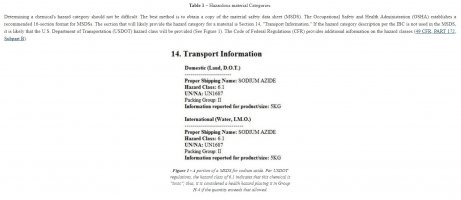The classification of hazardous materials to determine if they are classified as a Toxic or Highly Toxic is dependent on a review of the toxicity data. My source that I use is Sax’s Handbook of Dangerous Industrial Chemicals. Currently I have the 11th edition and it costs about $800. One can use the internet to look for this information but Sax’s produces the best work and references peer-reviewed toxicity data.
If you don’t have an understanding of the recognized pathways for toxins, factors that influence toxicity, or how LC50 or LD50 is derived (and can be misused), one should seek technical assistance. Commonly, everyone says call a Fire Protection Engineer. However, if you’re being asked to evaluate the hazardous material(s) I’ve found that a Certified Industrial Hygienist (CIH) has the required knowledge to make a determination in these matters.
The codes are NOT misaligned with the safety data sheets (SDS). The toxicity values in the IFC and IBC are based on toxicity exposure limits based on OSHA regulations for poisonous materials. A common misunderstanding is how the measurements equate to exposure of the human body to a toxin. The IFC regulates toxic and highly toxic materials based on the hazardous material being inhaled, absorbed through the skin, or ingested. The measurements are expressed using the following values:
-INHALATION: Parts per million (PPM) or milligrams/cubic meter (mg/M^3). Either PPM or mg/M^3 are applied when evaluating the volume of a substance per unit volume of air of a toxin administered to a test animal that meets the species and weight requirements. Note that PPM is mathematically 1 micro liter of gas per 1 liter volume of air so mathematically they are equivalent and can be converted from one to another. However, this is dependent on the molecular weight of the gas or mist. These values are used to determine LC50.
- ABSORBTION: milligrams/square centimeter (mg/M^2). Area is the driving factor because this measurement can be used to determine the amount of a toxin is required over the area of the test animal the toxin was administered to cause 50% of the test animals to die (LD50).
- INGESTION: milligram/kilogram (mg/Kg). The mass of the toxin and the weight of the test animal are measured and used as part of the reproducible experiments to determine the mass of toxin that causes 50% of the test animals to die (LD50).
One cannot establish a limit for a hazardous material without establishing the desired or undesired response. In the IFC the response is expressed as LC50 or LD50 and it is a time-exposure dependent value. That’s why the IFC sets the measurement based on a 1-hour exposure. As you found, LC50 values can be normalized to one-hour based if the measured results were for a different time period. We use to have these values in the 2000, 2003, and 2006 editions of the IFC Appendix because the code was changed to reference a Compressed Gas Standard for the classification of gases. I’ve included them below:
Normalization Factor
Time (hrs) Multiplier
0.5 0.7
1 1
1.5 1.2
2 1.4
3 1.7
4 2
5 2.2
6 2.4
7 2.6
8 2.8
Please note you cannot normalize an LD50 value for absorption because the measurement is based on the area of exposure. The same holds true for ingestion because the measurement is based on the weight of the doses and the test animals.
I’m not sure how else I can help you other than by classifying the hazardous materials. That would be awesome for you but I’m busy working for a little jurisdiction in Texas. If you have more questions ask, but I don’t come around here much because I’ve got other things more fun in my life like my job, going to the gym, cooking, and drinking bourbon.


